Substitute for Blueberries
When you need a substitute for blueberries, you've got several reliable options that maintain similar texture and flavor profiles. Fresh alternatives include blackberries, raspberries, or strawberries, which you can use in a 1:1 ratio for most recipes. For baking, blackberries and raspberries work especially well, though you'll want to adjust sugar levels since raspberries are typically more tart. Strawberries can work too, but you'll need to chop them to blueberry size and possibly drain excess moisture. Each substitute brings its own nutritional benefits, from vitamin C to antioxidants, and you'll find these alternatives work seamlessly in everything from muffins to smoothies. The key to perfect substitution lies in understanding each berry's unique characteristics.
This post may contain affiliate links. If you make a purchase through these links, I may earn a commission at no additional cost to you. Additionally, portions of this post may be generated using artificial intelligence (AI) technology. While we strive for accuracy, please be aware that AI-generated content may not always be perfect and should be fact-checked when necessary.
The Spatula Scoops
- Fresh blackberries, raspberries, strawberries, currants, and mulberries can substitute blueberries in a 1:1 ratio for most recipes.
- Strawberries should be chopped to blueberry size before substituting, and may require draining to control moisture levels.
- Raspberries are more tart than blueberries, so reduce recipe's liquid by 1-2 tablespoons and adjust sugar levels accordingly.
- Frozen mixed berries work well as substitutes in baked goods, smoothies, and jams when fresh alternatives aren't available.
- Each substitute berry offers similar antioxidant benefits and nutritional value, though vitamin and calorie content varies slightly.
Understanding Fresh Blueberries
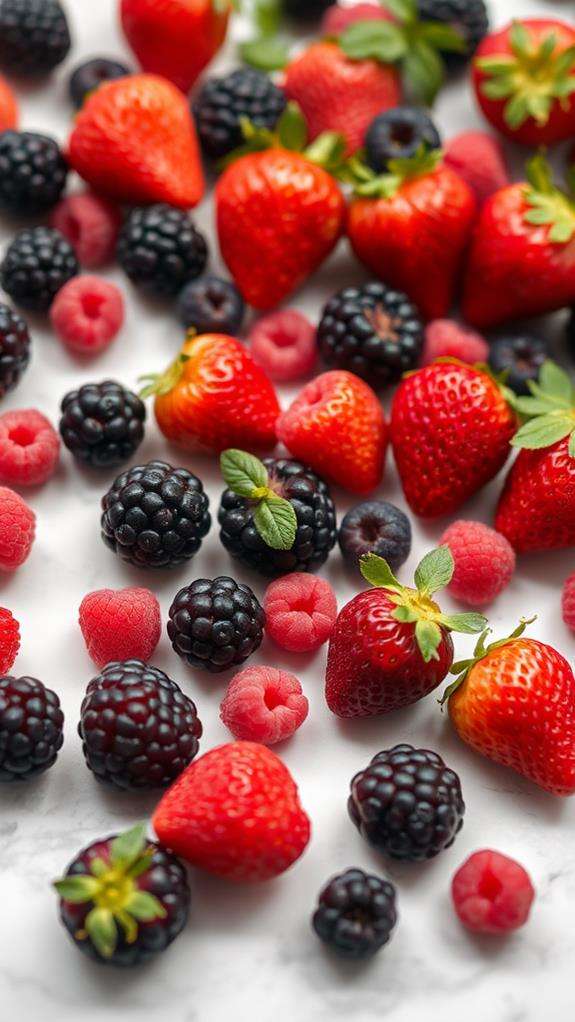
Understanding the nutritional profile of blueberries will help you appreciate their value as a superfood. They're packed with essential vitamins C and K, and you'll get about 57 calories per 100-gram serving. What makes these berries particularly special is their rich antioxidant content, specifically anthocyanins, which give them their distinctive deep blue color and provide numerous health benefits. Additionally, blueberries can be an excellent choice for complementing various dishes, similar to how a Lodge cast iron skillet can enhance flavors through its seasoning and heat retention versatile cooking options. You'll also benefit from minerals like manganese and copper, along with a healthy dose of dietary fiber.
When it comes to culinary uses, you've got plenty of options. You can enjoy them fresh as a snack, blend them into smoothies, toss them into salads, or incorporate them into your baking projects. They're particularly popular in muffins and pies, and you can transform them into delicious jams and sauces for various dishes.
Common Blueberry Uses
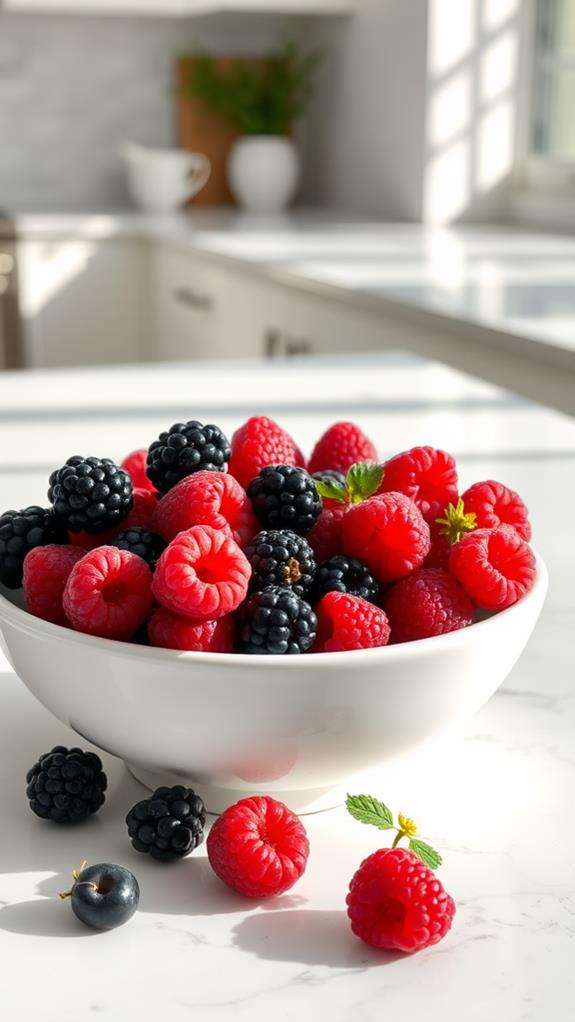
When you're ready to bake with fresh blueberries, you'll find they're perfect for muffins, pies, and other pastries where their natural juices create moist, flavorful results. Your breakfast options expand considerably with blueberries, as you can easily incorporate them into pancakes, waffles, or a warming bowl of oatmeal for added nutrition and taste. Whether you're folding them into your favorite batter or sprinkling them atop your morning yogurt, fresh blueberries maintain their shape and burst with flavor when heated, making them an ideal ingredient for both sweet and savory dishes.
Baking With Fresh Blueberries
Whether you're making muffins, pies, or pancakes, fresh blueberries bring natural sweetness and moisture to countless baked goods. When you're looking for a substitute for blueberries, it's important to understand their unique flavor profile and how they function in baking, particularly their tart flavor that balances perfectly with sweet batters.
To get the best results when baking with fresh blueberries, you'll want to coat them lightly in flour before adding them to your mixture. This simple technique prevents the berries from sinking to the bottom of your baked goods and guarantees even distribution throughout. You can incorporate blueberries in various ways: fold them gently into your batter, create a layered effect, or sprinkle them on top for visual appeal. Their high antioxidant content, especially anthocyanins, adds nutritional value to your treats without compromising taste. Don't limit yourself to sweet applications – these versatile berries work wonderfully in savory baked dishes too. Try adding them to cheese-based quiches or herb-infused bread recipes for an unexpected twist that'll enhance both flavor and presentation.
Blueberry Breakfast Ideas
Countless breakfast options come alive with the addition of blueberries, making them a versatile morning staple. When you're looking for healthy toppings to enhance your morning meal, you'll find that blueberries serve as an excellent fruit to use across various breakfast dishes. You can easily incorporate them into your oatmeal for natural sweetness, or blend them into smoothies for added nutrition and vibrant color.
If you're seeking a blueberry alternative for your morning routine, you'll want to contemplate how these berries function in different preparations. For instance, blueberry pancakes remain a classic choice, where you can use either fresh or frozen berries in the batter. When creating yogurt parfaits, you'll find that layering blueberries with granola and nuts provides a satisfying combination of textures and nutrients. For a simpler approach, try spreading them over whole grain toast or waffles. These breakfast applications showcase why blueberries are so popular in morning meals, offering both versatility and nutritional benefits. Whether you're preparing a quick breakfast or an elaborate brunch, blueberries can elevate ordinary dishes into something special.
Top Berry Alternatives
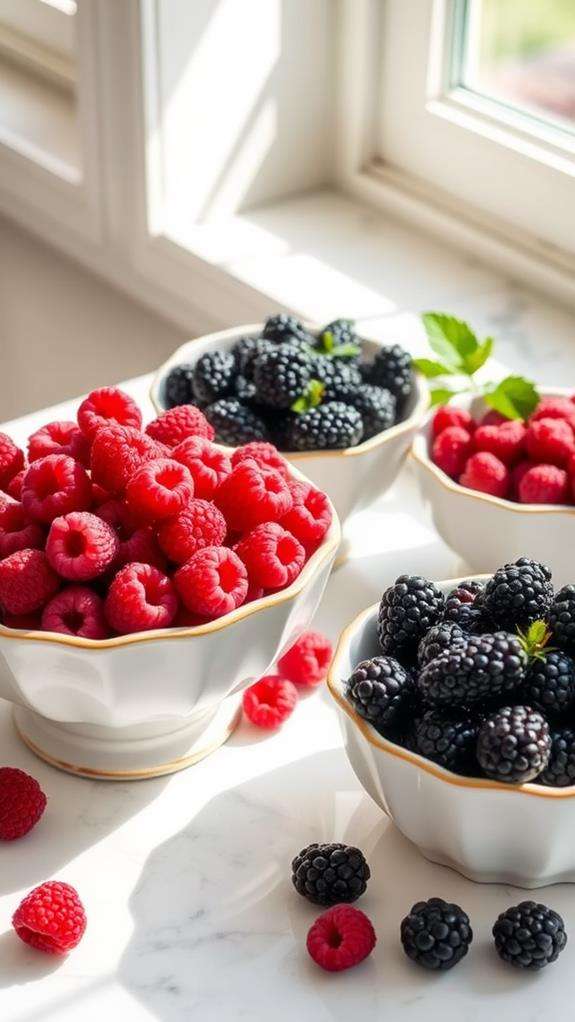
When you're out of blueberries, you'll find several fresh berry alternatives that match both the texture and flavor profile of your missing ingredient. You can confidently swap in blackberries, raspberries, strawberries, currants, or mulberries at a 1:1 ratio in your favorite recipes, whether you're baking muffins, making smoothies, or tossing together a fresh salad. These alternative berries not only maintain similar sweet-tart flavor notes but also bring their own unique characteristics to your dishes, with options like chopped strawberries working particularly well in baked goods and blackberries offering an excellent substitute in both cooked and raw applications.
Fresh Berry Swap Options
Several fresh berries step in perfectly as blueberry substitutes, offering similar textures and complementary flavors in your favorite recipes. You'll find that blackberries and raspberries provide excellent 1:1 substitutions, while maintaining the juicy characteristics you're looking for in your dishes.
| Berry Type | Flavor Profile | Best Uses |
|---|---|---|
| Blackberries | Tart, juicy | Pies, muffins, jams |
| Raspberries | Sweet, mild tart | Tarts, yogurt toppings |
| Strawberries | Sweet, firm | Baked goods, smoothies |
| Currants | Tart, slightly sweet | Jams, sauces |
| Mulberries | Mildly sweet, subtle tart | Pies, salads |
When you're working with these substitutes, remember that each brings its own unique characteristics. Strawberries might require you to adjust sugar levels slightly, while currants naturally need less sweetening. You'll find mulberries particularly versatile, working well in both sweet and savory applications. For the most seamless swap, consider the moisture content of your chosen substitute – blackberries and raspberries match blueberries most closely in this regard, making them ideal for baked goods where texture is essential.
Baking With Alternative Berries
Baking with alternative berries opens up exciting possibilities for your kitchen creations. When you're out of blueberries, you'll find several berries that can serve as excellent substitutes in your recipes. Each alternative brings its own unique flavor profile and baking characteristics to your dishes.
- Blackberries offer a sweet-tart balance that works wonderfully in pies and muffins, maintaining proper moisture levels in your baked goods
- Raspberries deliver a pronounced tartness that's perfect for tarts and cakes, while adding a stunning red hue to your creations
- Strawberries, when chopped to blueberry size, provide the right texture and sweetness for quick breads and desserts
- Currants bring an intense tartness that elevates scones and pastries, particularly effective in jam-based recipes
- Mulberries offer a mild sweetness that's ideal for muffins and make excellent toppings for various baked treats
When substituting these berries in your baking projects, you'll want to take into account their moisture content and sweetness levels. For instance, raspberries might require less sugar than blueberries, while strawberries may need to be drained slightly to prevent excess moisture in your finished product.
Matching Flavor Profiles
Finding the perfect berry substitute depends largely on matching flavor profiles to your intended dish. When you're looking for the best substitutes for blueberries, you'll want to take into account both taste and texture characteristics to guarantee your recipe maintains its intended appeal.
| Berry Type | Flavor Profile | Best Used In |
|---|---|---|
| Raspberries | Sweet-tart | Desserts, Baking |
| Blackberries | Sweet-juicy | Jams, Smoothies |
| Strawberries | Sweet-firm | Salads, Desserts |
| Currants | Bold-intense | Jams, Savory Dishes |
You'll find that raspberries offer a similar sweetness to blueberries but with an enhanced tartness that works exceptionally well in baked goods. If you're making smoothies or jams, blackberries provide a comparable sweet-tart balance and juicy texture. For salads and fresh preparations, you can use chopped strawberries as they'll provide the right size and visual appeal. When you need a more intense flavor, particularly in preserves or cooking, black currants deliver a deeper taste profile that can elevate your dish. Weigh the moisture content and sweetness level of your substitute to maintain the recipe's intended balance.
Adjusting Recipe Measurements
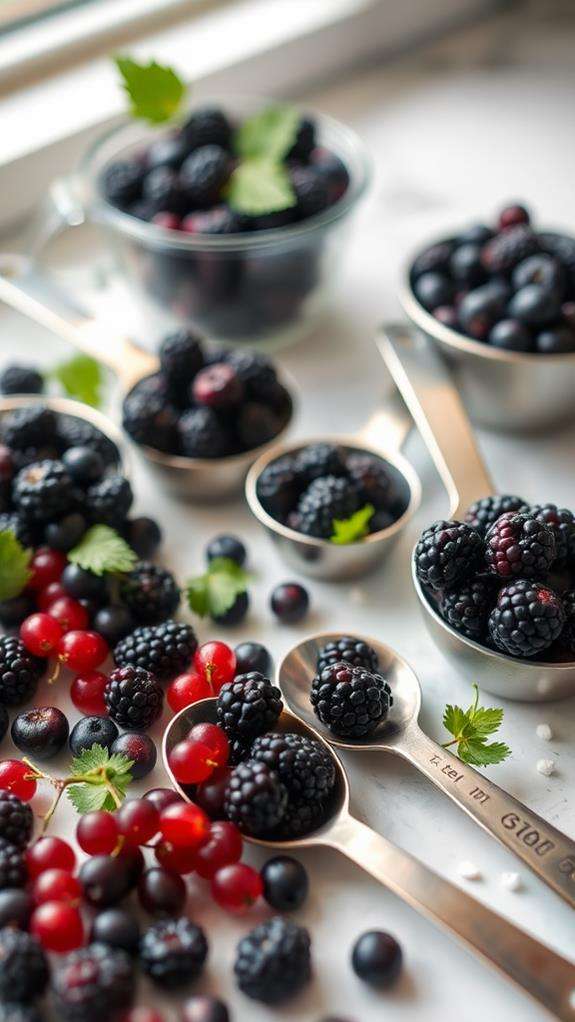
Making the switch from blueberries to alternative fruits requires careful attention to measurement adjustments. When you're adjusting recipe measurements, take into account both the moisture content and natural sweetness of your chosen substitute. To achieve the perfect flavor and texture, you'll need to make thoughtful modifications based on your replacement for raw blueberries.
Here's what you'll need to reflect on when making substitutions:
- Use a 1:1 ratio when replacing blueberries with raspberries or blackberries, but adjust sugar levels according to the fruit's tartness
- Reduce liquid ingredients by 1-2 tablespoons when using raspberries to compensate for their higher moisture content
- Chop strawberries to match blueberry size for even distribution throughout your recipe
- Measure denser substitutes like currants or mulberries in slightly smaller quantities
- Start by testing small batches to perfect your adjustments before scaling up
Remember that each fruit substitute brings its own unique characteristics to your recipe. While maintaining proper proportions is essential, don't hesitate to make minor adjustments based on your taste preferences and the specific requirements of your dish. Keep notes of successful modifications for future reference.
Best Choices for Baking
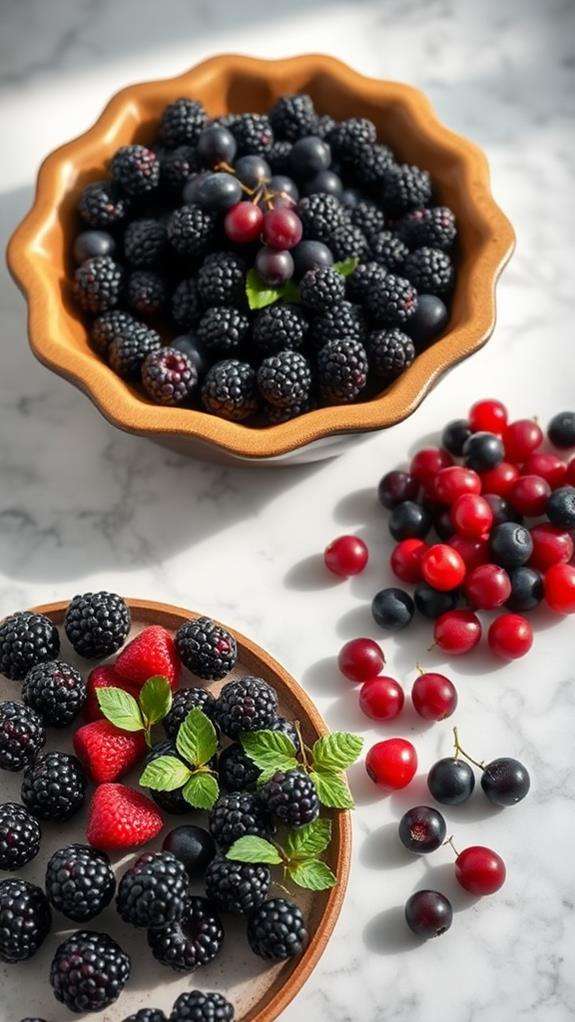
When it comes to baking, several fruits can step in admirably for blueberries while maintaining the delicious results you're after. Among the best blueberry substitutes, blackberries are an excellent substitute that you can use in a straightforward 1:1 ratio, offering similar juiciness and a delightful sweet-tart balance in your baked goods. Additionally, these berries are high in antioxidants, which are beneficial for heart health and can enhance your dish's nutritional profile, similar to the benefits of watercress. Raspberries are a great replacement for your favorite recipes, though you'll need to handle them gently due to their delicate nature. You'll find they work particularly well in tarts and cobblers, providing a bright pop of color and mild tartness. If you're looking for a firmer option, chopped strawberries can serve as a great replacement for raw blueberries in breads and cakes, matching the original measurements exactly. For more intense flavors, try black currants in your pastries and jams, but remember to adjust your sugar content accordingly. Mulberries offer another versatile choice, bringing a balanced sweet-tart profile that works beautifully in pies, tarts, and breakfast dishes. You can substitute them in equal amounts, making them an easy swap in your favorite recipes.
Flavor and Texture Comparisons
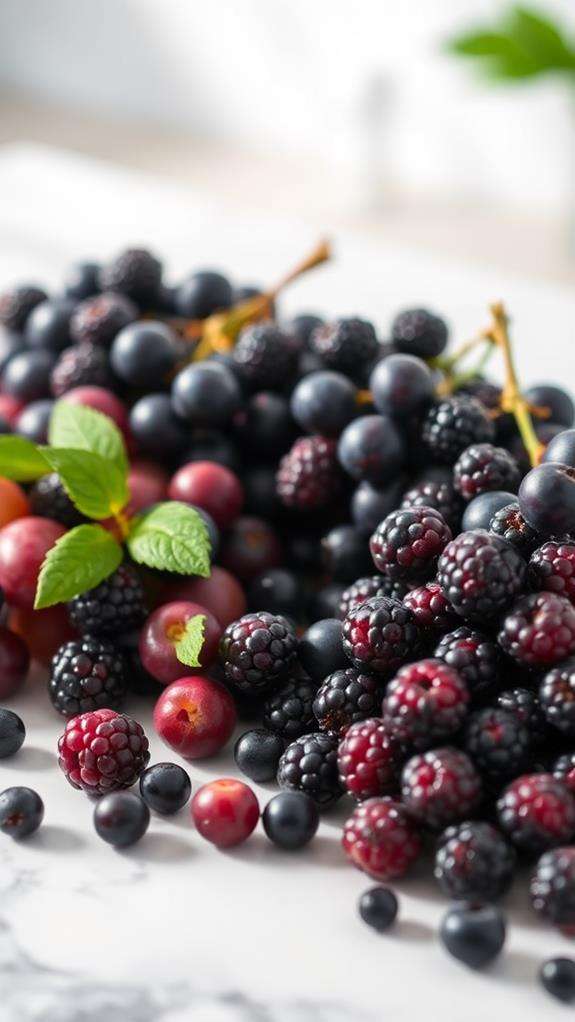
Each substitute for blueberries brings its own distinctive characteristics to your recipes. When you're considering a replacement, you'll need to think about both flavor and texture profiles to make the best choice for your dish. Understanding these differences will help you achieve results that closely match your original recipe's intended outcome. For instance, nutritional yeast is a great addition that can enhance the savory profile of certain dishes, providing a savory vegan cheese substitute while complementing the sweet flavors commonly found in blueberry recipes.
- Raspberries offer a more tart flavor profile than blueberries, and you'll need to adjust your sugar content when using them as substitutes.
- Blackberries provide a similar sweet-tart balance to blueberries but come with larger seeds that add unexpected crunch.
- Strawberries, when chopped to size, can match blueberries' texture while offering a sweeter flavor.
- Blueberries' smooth, firm texture makes them ideal for baking, so consider this when choosing alternatives.
- Your chosen replacement should account for both moisture content and structural integrity in the final dish.
When you're working with these substitutes, remember that texture differences can considerably impact your recipe's outcome. For instance, raspberries' delicate structure means you'll need to handle them with extra care during mixing and folding. You'll find that each alternative brings unique characteristics that can either enhance or alter your recipe's final result.
Storage and Shelf Life
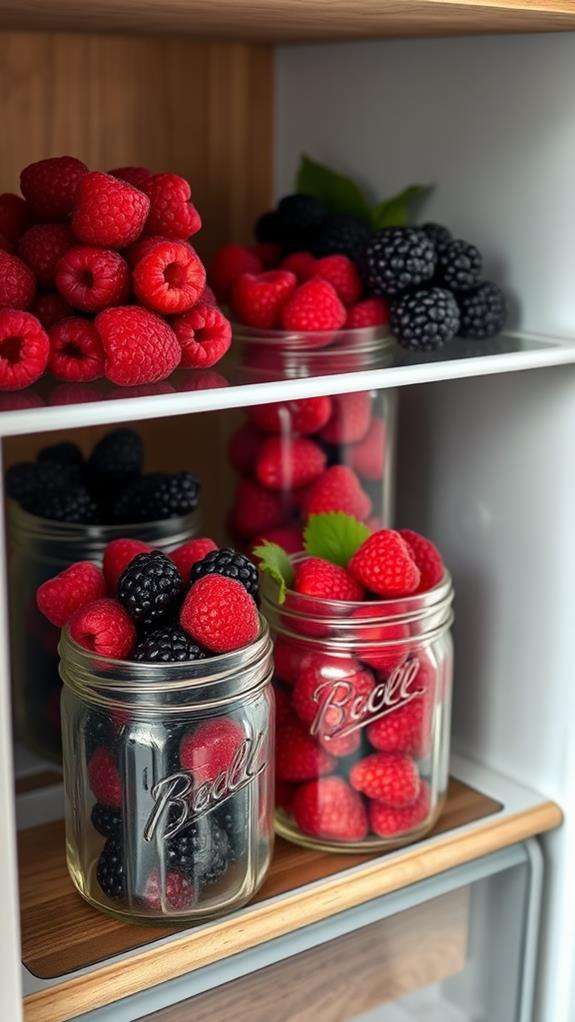
Proper storage techniques can make or break the success of your blueberry substitutes in recipes. When you're working with substitutes for blueberries, it's essential to understand their unique storage requirements to maximize their shelf life and maintain quality.
| Product Type | Storage Method | Shelf Life |
|---|---|---|
| Fresh Berries | Refrigerator in breathable container | 5-10 days |
| Frozen Options | Freezer in airtight bags | 10-12 months |
| Dried Varieties | Cool, dry place in sealed container | 12-24 months |
You'll want to store fresh blueberries and their substitutes in the refrigerator using breathable containers to prevent moisture buildup. If you're working with frozen blueberries or their alternatives, keep them in airtight freezer bags to prevent freezer burn. For maximum storage life, dried substitutes should be kept in sealed containers away from direct sunlight. When storing homemade preparations like jams or sauces made with blueberry substitutes, use sterilized jars and keep them refrigerated for up to a month. Remember to inspect your stored items regularly for any signs of spoilage, as one bad berry can quickly affect the entire batch.
Seasonal Availability of Substitutes
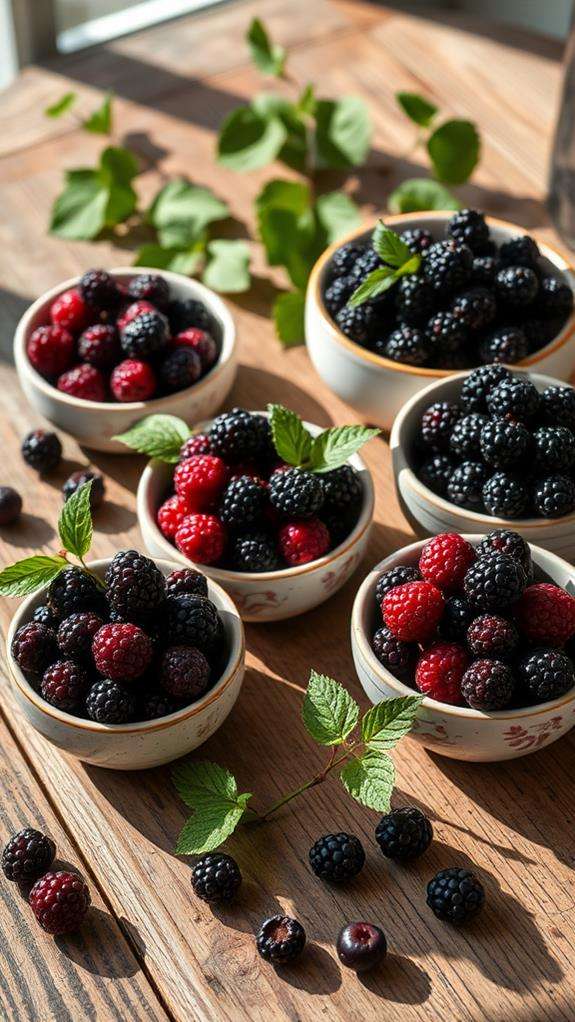
Understanding the seasonal availability of blueberry substitutes can help you plan your recipes throughout the year. When you can't find fresh blueberries, you'll want to know which alternatives are in season and readily available at your local market.
Here's when you can find various blueberry substitutes throughout the year:
- Raspberries and strawberries share blueberries' late spring to early summer season, making them convenient substitutes when you need fresh berries
- Mulberries offer a local foraging option during late spring and early summer, perfectly coinciding with blueberry season
- Blackberries become available in mid-summer and continue through early fall, providing a seamless shift as blueberries phase out
- Cranberries take center stage from September through November, offering a tart substitute for your fall recipes
- Acai berries peak during warmer months when imported from tropical regions
You'll find that seasonal availability varies by region and climate conditions. When planning your recipes, consider these seasonal patterns to guarantee you're using substitutes at their peak freshness. This approach not only assures better flavor but often results in more cost-effective ingredient choices throughout the year.
Nutritional Value Comparisons
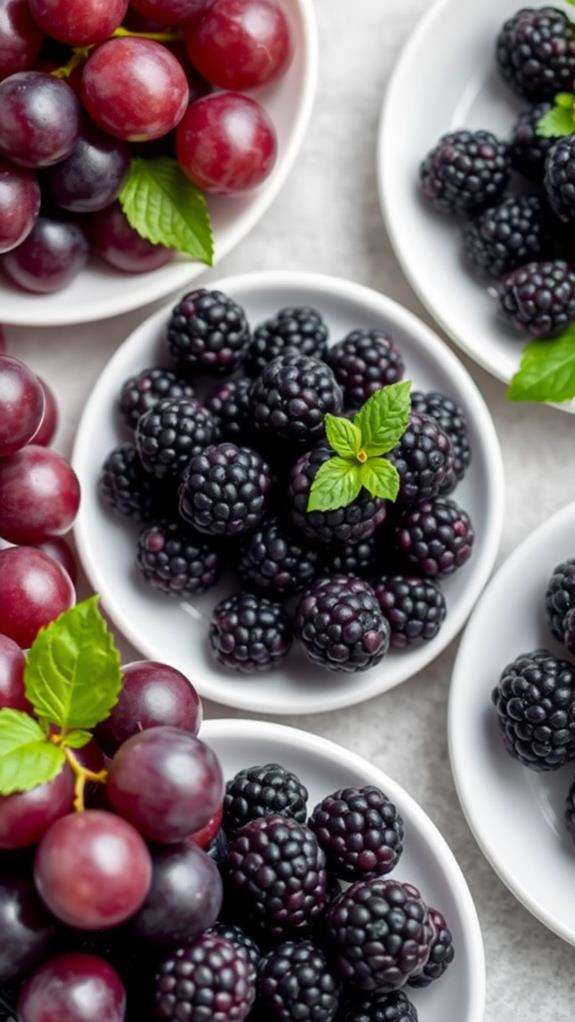
When comparing blueberry substitutes up against the original fruit, you'll find significant variations in their nutritional profiles. While blueberries contain 57 calories per 100 grams and offer substantial amounts of vitamins C and K, each potential substitute brings its own unique nutritional value to the table.
If you're looking for a lower-calorie substitute, strawberries are your best option at just 32 calories per 100 grams, and they'll actually provide you with more vitamin C than blueberries – nearly six times as much. Raspberries, though slightly lower in calories than blueberries at 52 calories, offer an impressive 6.5 grams of dietary fiber, making them an excellent choice if you're focusing on digestive health. Blackberries provide similar vitamin K content to blueberries at 20.5 µg per 100 grams but come with fewer calories at 43 per serving. For those interested in antioxidant properties, cranberries can serve as a worthy substitute, offering unique compounds called proanthocyanidins that you won't find in the same concentrations in blueberries. Each alternative provides distinct nutritional benefits that might better align with your specific dietary needs.
Frequently Asked Questions
What Can You Have Instead of Blueberries?
You can replace blueberries with several delicious alternatives that'll work just as well in your recipes. Blackberries are your closest match, offering a similar sweet-tart profile and working perfectly in a 1:1 ratio. You'll also find raspberries and chopped strawberries make excellent substitutes, maintaining the same proportions. If you're feeling adventurous, try black currants for a more intense flavor, or pomegranate seeds for added crunch in salads and desserts.
Which Fruit Is Equal to Blueberry?
Like stars in the night sky, each berry shines with its own unique light, but some shine remarkably close to blueberries. You'll find blackberries and raspberries are your closest matches, offering a similar sweet-tart profile in a 1:1 ratio. Strawberries, when chopped, can mirror blueberries' texture perfectly, while mulberries provide comparable juiciness. If you're looking for intensity, black currants deliver a concentrated flavor, though you'll want to use them more sparingly.
What Fruit Is Similar to a Blueberry?
You'll find several fruits that share blueberry's unique flavor profile and texture. Raspberries and blackberries offer that perfect sweet-tart balance you're looking for, while strawberries provide a similar sweetness when chopped. If you're seeking that distinctive tartness, currants make an excellent match. Don't forget about cherries, which can mirror blueberries' juicy texture and rich flavor profile. Each of these alternatives works wonderfully in recipes calling for blueberries.
What Is Similar to Blueberries Nutrition?
You'll find that raspberries, blackberries, and cranberries share similar nutritional profiles with blueberries. They're all rich in antioxidants and dietary fiber, supporting your digestive health. Strawberries pack even more vitamin C than blueberries, while acai berries match blueberries' impressive antioxidant levels. Each of these berries delivers comparable health benefits through their fiber content, ranging from 3.6 to 6.5 grams per cup, and essential vitamins like C and K.





